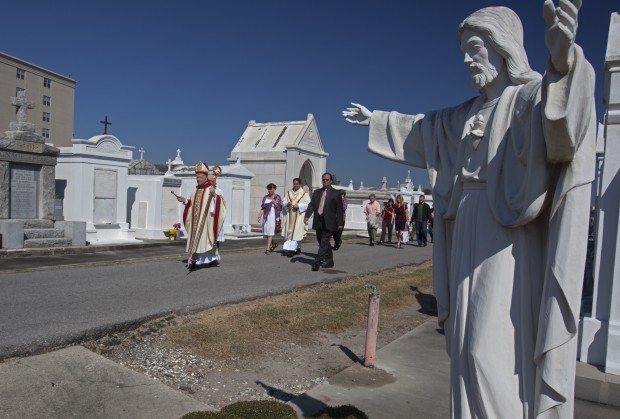BROWNSVILLE, Texas (CNS) — Death does not mean the end.
“Life is changed, not ended,” said Father Gregory Labus, coordinator of the Office of Liturgy and Worship for the Diocese of Brownsville.
November, he pointed out, is the month dedicated to remembering the dead.
[hotblock]
On All Saints’ Day, Nov. 1, Catholics honor the saints, and on All Souls’ Day, Nov. 2, Catholics not only remember those who have died but they also celebrate life, said the priest, pastor of St. Joseph Church in Edinburg, Texas.
In the Rio Grande Valley area of south Texas, one tradition to mark All Souls’ Day — Dia de los Muertos (Day of the Dead) — is experiencing a resurgence. It involves making an altar in memory of family and friends who have died.
“Undoubtedly, this is a custom that is growing. … It awakens once again that consciousness that was getting lost,” Father Ignacio Luna, pastor at St. Benedict Church in San Benito, told The Valley Catholic, Brownsville’s diocesan newspaper.
“It makes people think about the future, about death and not just about the material world, but about how we live our lives and treat others,” he added.
Each year at his parish, Father Luna sets up an altar for the dead so that parishioners may bring photos of their loved ones and place their “ofrendas,” items the deceased liked, such as flowers, food or candy.
Father Jorge Gomez, diocesan chancellor and pastor of Holy Family Church in Brownsville, said the tradition goes back to the Aztecs and the Mayans.
“For God no one is dead, everyone is alive, and we celebrate their lives,” he said. “It’s a way to commemorate and remember people we love. … As long as we remember, they’re still alive in our hearts and minds.”
Father Luna, who grew up in Mexico, remembers elaborate Day of the Dead preparations from his childhood that continue in many parts of Mexico. He said the bright colors used — vivid oranges, greens, purples, yellows and reds — “manifest the joy because there is no sadness, no mourning, no use of black. There is simply joy and happiness because their souls are already in God’s hands.”
“Es una fiesta no para llorar, sino para gozar,” he said. In English: “It is not a feast for crying, it is one to enjoy.”
“It’s a cultural way of looking at death. … ‘La muerte no triunfa.’ We celebrate life, not death. We are not afraid of death because death does not have the final word in this life,” Father Gomez said.
Sister Norma Pimentel, a Missionary of Jesus, who is diocesan director of Catholic Charities, said that creating an altar to remember the dead can help in the healing process of dealing with the death of a loved one. “It helps us accept and recognize that we are born of the earth and return to it.”
“We celebrate death and elevate them (loved ones) to God. We accept every aspect of our lives,” she added.
One aspect of All Souls’ Day that tends to get lost in the United States is “the doctrine of purgatory,” which “has been overshadowed,” Father Labus said. Since the Second Vatican Council, he noted, “there has not been as much emphasis for prayer for the dead.”
The liturgical readings during this time of year shift to the end of times when God comes in glory and calls his people home, he said. “The Gospel readings focus on the idea that we must always be prepared and ask us to reflect on the question: Have we lived our lives according to the Gospels?”
“It’s all tied together,” Father Labus said. “On All Souls’ Day we pray and remember the dead, and we are reminded that we will follow and should live the Gospel now.”
***
Riojas is editor of The Valley Catholic, newspaper of the Diocese of Brownsville.
PREVIOUS: Catholic hospital systems, including Catholic Health East, mulling merger
NEXT: Catholic-owned Michigan company wins injunction against HHS mandate




Share this story